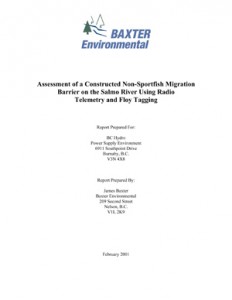Reports are entered in chronological order; leading with the most recent reports.
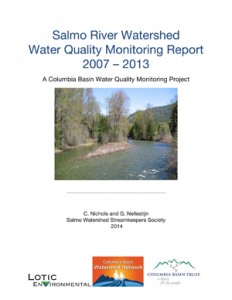 Salmo River Watershed Water Quality Monitoring Report 2007 – 2013: A Columbia Basin Water Quality Monitoring Project; Salmo Watershed Streamkeepers Society; C. Nichols, G. Nellestijn; 2014; 113 pgs.
Salmo River Watershed Water Quality Monitoring Report 2007 – 2013: A Columbia Basin Water Quality Monitoring Project; Salmo Watershed Streamkeepers Society; C. Nichols, G. Nellestijn; 2014; 113 pgs.
Habitat assessment and benthic macro-invertebrate sampling following CABIN protocols, continuous temperature monitoring, and water quality analysis occurred at three sites on the Salmo River from 2007 to 2012. Site NESLM01 is downstream of the Village of Salmo. NESLM02 is downstream of the community of Ymir and upstream of the Village of Salmo. Site NESLM03 is near the headwaters of the Salmo River.
CABIN monitoring protocols, including benthic macro-invertebrate sampling, occurred at each site annually in the fall. Non-metal water quality analysis was conducted at each site at this time. Metals in the water were analyzed in 2007, 2008, and 2009 at NESLM02. Metals in the sediment were analyzed in 2010, 2011, and 2012 at NESLM02. Non-metal water quality analysis was also conducted monthly from 2009 to 2013 at NESLM02. Continuous temperature monitoring occurred at each site with varied annual monitoring dates.
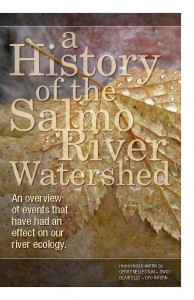 A History of the Salmo River Watershed: An overview of events that have had an effect on our river ecology; Salmo Watershed Streamkeepers Society: Gerry Nellestijn, Department of Fisheries & Oceans Canada: Blair Ells; December 2008; 16 pgs.
A History of the Salmo River Watershed: An overview of events that have had an effect on our river ecology; Salmo Watershed Streamkeepers Society: Gerry Nellestijn, Department of Fisheries & Oceans Canada: Blair Ells; December 2008; 16 pgs.
A chronological summary of events and impacts that have affected the Salmo River from pre-1807 to 2008.
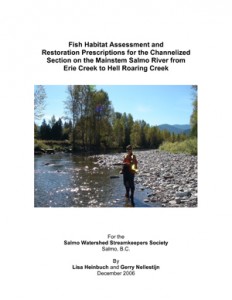 Fish Habitat Assessment and Restoration Prescriptions for the Channelized Section on the Mainstem Salmo River from Erie Creek to Hell Roaring Creek; Lisa Heinbuch and Gerry Nellestijn; December 2006; 40 pgs.
Fish Habitat Assessment and Restoration Prescriptions for the Channelized Section on the Mainstem Salmo River from Erie Creek to Hell Roaring Creek; Lisa Heinbuch and Gerry Nellestijn; December 2006; 40 pgs.
In the summer base flows of September 2006, the condition of salmonid habitat was assessed for 3.25 km. of the Salmo River main stem from Erie Creek to Hell Roaring Creek using the Fish Habitat Assessment Procedure (FHAP) applied in BC’s Watershed Restoration Program (1994-2002). Fish Habitat restoration prescriptions were also completed in featureless habitat units or where streambank erosion was evident. The area covered by this FHAP is commonly known, by those who have worked in the Salmo from a fisheries perspective as the ‘Biological Deadzone’. This area lies within Reach 2 – South Salmo River to Erie Cr., as determined by the Salmo Watershed Planning Team (WPT) and was specifically identified by them for FHAP/Prescription work as one of the many channelized areas in the system.
Fish habitat rehabilitation of this section of the Salmo River should be beneficial to Salmo River fish production. This rehabilitation could significantly increase the abundance of rainbow trout and bull trout char within a regionally significant sport fishery.
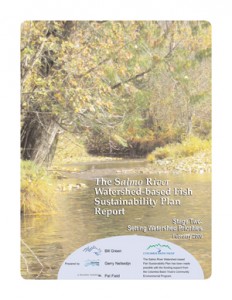 The Salmo River Watershed-based Fish Sustainability Plan Report; Stage Two: Setting Watershed Priorities; Columbia Kootenay Fisheries Renewal Partnership: Bill Green, Salmo Watershed Streamkeepers Society: Gerry Nellestijn, A Boulder Institute: Pat Field; February 2006; 234 pgs.
The Salmo River Watershed-based Fish Sustainability Plan Report; Stage Two: Setting Watershed Priorities; Columbia Kootenay Fisheries Renewal Partnership: Bill Green, Salmo Watershed Streamkeepers Society: Gerry Nellestijn, A Boulder Institute: Pat Field; February 2006; 234 pgs.
Stage II of the Salmo River Watershed-based Fish Sustainability Plan has been lengthy but rewarding. Starting in early 2000 the Columbia Kootenay Fisheries Renewal Partner (CKFRP) supported the ‘Salmo Working Group’. By late June, the Working Group reached consensus for immediate conservation and restoration projects, as well as conditional support for a strategic planning initiative.
Collaborative, community-based stewardship was seen as an essential characteristic for increasing the health of the aquatic ecosystem in the Salmo River Watershed.
In 2002, the Salmo Watershed Streamkeepers Society (SWSS) joined the CKFRP and proposed that the strategic planning initiative should adopt the Watershed-based Fish Sustainability Planning (WFSP) framework developed by the governments of B.C. and Canada, whose overall goal is to ensure “longterm conservation of fish and fish habitat”. This proposal was endorsed and a Watershed Planning Team (WPT) and a Watershed Technical Team (WTT) were formed in the summer of 2002 with a broad representation of watershed interests, including industry, government and community and technical expertise. As a critical first step in the WFSP process, consultants were contracted to prepare detailed Watershed and Riparian Profiles. Following completion and adoption of these profiles in the summer of 2003, a series of WPT, WTT and public meetings were held between September 2003 and March 2004, to gather community input and direction with a view to developing a plan and setting priorities for the Salmo River watershed. The outcome was the establishment of three plan components – a strategic overview, a strategic direction and strategic options. From the many options that were discussed and considered, five key objectives were selected as priority areas.
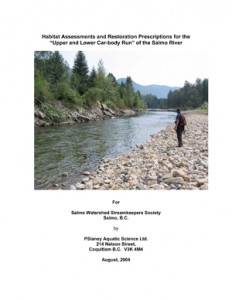 Habitat Assessments and Restoration Prescriptions for the “Upper and Lower Car-body Run” of the Salmo River; PSlaney Aquatic Science Ltd.; August, 2004; 36 pgs.
Habitat Assessments and Restoration Prescriptions for the “Upper and Lower Car-body Run” of the Salmo River; PSlaney Aquatic Science Ltd.; August, 2004; 36 pgs.
During mid-August of 2004, the condition of salmonid habitat in the Salmo River was assessed for 1.9 km using the Fish Habitat Assessment Procedure within what is known locally as the “upper and lower car body runs”. Habitat restoration prescriptions were also completed simultaneously over a distance of 1.9 km.
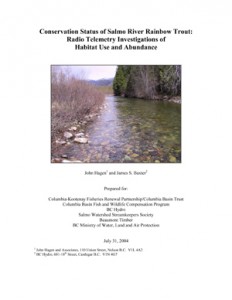 Conservation Status of Salmo River Rainbow Trout: Radio Telemetry Investigations of Habitat Use and Abundance; John Hagen and Associates: John Hagen, BC Hydro: James S. Baxter; July 2004; 82 pgs.
Conservation Status of Salmo River Rainbow Trout: Radio Telemetry Investigations of Habitat Use and Abundance; John Hagen and Associates: John Hagen, BC Hydro: James S. Baxter; July 2004; 82 pgs.
Prior to 2001, biologists were unable to assess the conservation status of the rainbow trout (Oncorhynchus mykiss) population inhabiting the mainstem of the Salmo River due to limited information about trends in abundance, habitat use, and life history. To address these deficiencies, we initiated during 2001 a multiyear study of habitat use and population size for this population employing radio telemetry as a primary investigative tool.
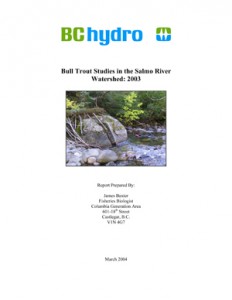 Bull Trout Studies in the Salmo River Watershed: 2003; James Baxter; March 2004; 27 pgs.
Bull Trout Studies in the Salmo River Watershed: 2003; James Baxter; March 2004; 27 pgs.
This report summarizes the results of bull trout monitoring conducted by BC Hydro in the Salmo River watershed in 2003. Work undertaken included index swims within the mainstem Salmo River, and spawner and redd counts in known headwater and tributary spawning areas that have been surveyed over the past several years. In total, one watershed wide survey (over several days) and five index section surveys were conducted by snorkel survey. During redd surveys, a total of 105 redds and 38 spawners were enumerated. We observed spawners and redds in all areas that were previously identified (Clearwater Creek, Sheep Creek, the upper Salmo River, and the South Salmo River watershed), and we continued our surveys in 2003 within the entire South Salmo River within the U.S. Sheep Creek and the upper Salmo River/Clearwater Creek area were the areas of the highest concentration of spawning activity in 2003. Spawning activity was extremely limited in the South Salmo watershed, but the upper barrier on the river was confirmed. When the counts of redds and spawners within the watershed are expanded to provide an estimate of escapement, 2003 marks the highest estimate of escapement in the 6 years the study has been undertaken (196 fish in 2003). It is possible we are observing the first response of the population to the implementation of the catch and release regulation in 1999, and future monitoring is recommended.
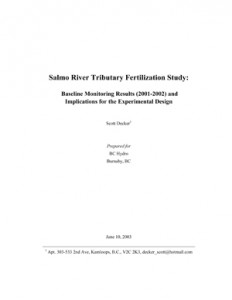 Salmo River Tributary Fertilization Study: Baseline Monitoring Results (2001-2002) and Implications for the Experimental Design; Scott Decker; June 2003; 72 pgs.
Salmo River Tributary Fertilization Study: Baseline Monitoring Results (2001-2002) and Implications for the Experimental Design; Scott Decker; June 2003; 72 pgs.
As compensation for the installation of a fourth unit at the 7 Mile Generating station, BC Hydro agreed to fund an experimental stream fertilization project. To test the effect of stream fertilization on the production of juvenile bull trout and other fish species in Salmo River tributaries, a six year before-after-control experiment (3 baseleine and 3 treatment years) was initiated in two tributaries; Sheep Creek and the South Salmo River. During 2001and 2002, two years of baseline abundance data were collected for juvenile fish, benthic macroinvertebrates, periphyton biomass and water chemistry. Results indicate that phosphorus and nitrogen were at or below detection limits, and periphyton biomass was also very low (0.9 to 2.5 μg/cm2 chlorophyll a), suggesting both streams are nutrient limited. Estimates of mean invertebrate density (900-3,400 total organisms/m2) and salmonid biomass (1.6-2.8 g/m2) also appeared low compared to values reported for other systems. Both study tributaries appear to be good candidates for a fertilization trial; For logistical reasons, Sheep Creek is likely the best choice as the treatment stream for the experiment. Use of calibrated single-pass electrofishing as a rapid assessment method to estimate fish numbers resulted in a 250% increase in sampling efficiency compared to conventional three-pass electrofishing and provided relatively precise population estimates despite high spatial heterogeneity in abundance (95% CI: ±14%-51% and ±17%-27% for fish density and biomass, respectively). Precision of the estimates of macroinvertebrate density and biomass in 2001 and 2002 was comparable to that obtained for juvenile fish populations (±16%-±19% and ±21%-±35%, respectively). The relatively good precision of the abundance estimates for juvenile fish and macroinvertebrates, coupled with limited evidence that fish populations in the study tributaries may be fairly stable –( mean bull trout and rainbow trout densities differed by less than 10% in 2001 and 2002) – suggest that a 6 year study should have a relatively high probability (> 0.8) of detecting a response in fish production to fertilization provided the increase exceeds about 35% of pre-treatment levels. It should be emphasized that conclusions from two years of monitoring are preliminary, and statistical power should be revaluated in 2003/2004 prior to fertilization.
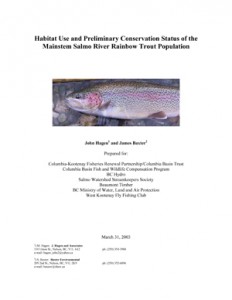 Habitat Use and Preliminary Conservation Status of the Mainstem Salmo River Rainbow Trout Population; John Hagen, Baxter Environmental: James Baxter; March 2003; 95 pgs.
Habitat Use and Preliminary Conservation Status of the Mainstem Salmo River Rainbow Trout Population; John Hagen, Baxter Environmental: James Baxter; March 2003; 95 pgs.
Prior to 2001, biologists have been unable to assess the conservation status of the rainbow trout population inhabiting the mainstem of the Salmo River due to limited information about trends or current levels of abundance, habitat use, and life history. To address these deficiencies, we initiated during 2001 a multi-year study of habitat use and population size employing radio telemetry as a primary investigative tool.
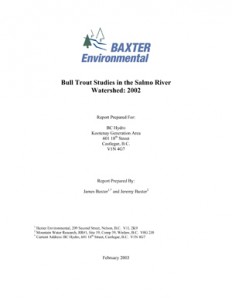 Bull Trout Studies in the Salmo River Watershed: 2002; Baxter Environmental: James Baxter, Mountain Water Research: Jeremy Baxter; February 2003; 23 pgs.
Bull Trout Studies in the Salmo River Watershed: 2002; Baxter Environmental: James Baxter, Mountain Water Research: Jeremy Baxter; February 2003; 23 pgs.
This report summarizes the results of bull trout monitoring in the Salmo River watershed in 2002 by BC Hydro. Work conducted in 2002 included index swims within the mainstem Salmo River, and spawner and redd counts in known headwater and tributary spawning areas. In total, seven swim surveys were conducted from July 9 to August 1, 2002. Bull trout were present in higher numbers in early summer within the surveyed section of the mainstem Salmo River, but had likely begun upstream spawning migrations by the end of July. In total, 21 redds and 89 spawners were enumerated in 2002. As previously documented, bull trout spawners and redds were observed in Sheep Creek, Clearwater Creek, the upper section of the Salmo River, and in Stagleap Creek and the South Salmo River (in the fall of 2002 all available South Salmo River habitat was surveyed in both the U.S. and Canada). The data suggested that 2002 was a poor year for bull trout spawning escapement within the Salmo River watershed. In particular, spawning activity in Clearwater Creek was reduced in 2002. Sheep Creek and the South Salmo River watershed were the areas of the highest concentration of spawning activity. As in 2001, swim observers enumerated more bull trout spawners and reeds than traditional bank observers. This report also standardizes estimates of escapement over the past five years in order to allow annual comparisons of escapement.
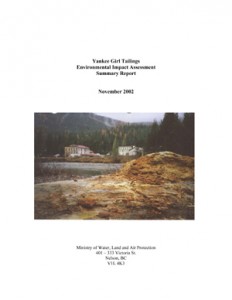 Yankee Girl Tailings Environmental Impact Assessment Summary Report; Ministry of Water, Land and Air Protection; November 2002; 39 pgs.
Yankee Girl Tailings Environmental Impact Assessment Summary Report; Ministry of Water, Land and Air Protection; November 2002; 39 pgs.
The Yankee Girl mill tailings are located on the east side of the Salmo River immediately across from the community of Ymir, BC. The tailings cover approximately two hectares, and are in close proximity to the Salmo River, a regionally significant fish bearing stream, with active water licenses downstream of the tailings. The tailings are easily accessible and recreational use of the site is common. Concerns about the tailings raised by the Salmo Watershed Streamkeepers Society prompted the Ministries of Water, Land and Air Protection and Energy and Mines to conduct limited site investigations involving water and soil sampling within or near the residues. Analytical tests of the soils revealed elevated levels of arsenic, cadmium, lead, silver and zinc concentrations exceeding numerical soil standards of the Contaminated Site Regulation. Cadmium and lead in soil were also demonstrated to have a high leachate potential. Based on comparison to leachate quality standards of the Special Waste Regulation, the sampled tailings qualify as special waste. The elevated concentration of arsenic in soil also qualifies the residues as special waste.
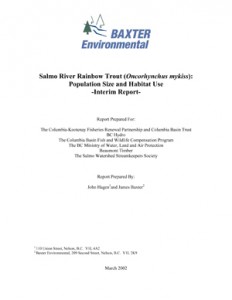 Salmo River Rainbow Trout (Oncorhynchus mykiss): Population Size and Habitat Use, Interim Report; John Hagen, Baxter Environmental: James Baxter; March 2002; 50 pgs.
Salmo River Rainbow Trout (Oncorhynchus mykiss): Population Size and Habitat Use, Interim Report; John Hagen, Baxter Environmental: James Baxter; March 2002; 50 pgs.
This interim report summarizes the initial field work and data collection of a project on the rainbow trout (Oncorhynchus mykiss) population of the Salmo River watershed. A total of 30 rainbow trout were radio tagged in the mainstem Salmo River in proportion to the abundance of rainbow trout >30 cm throughout the system. We used the radio tagged rainbow trout to derive a population estimate through a repetitive mark-recapture estimate in an index section over the summer, and have tracked the radio tagged fish to their summering and overwintering habitats.
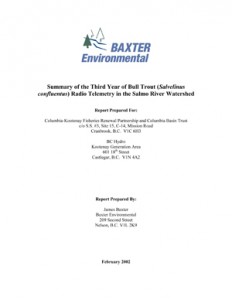 Summary of the Third Year of Bull Trout (Salvelinus confluentus) Radio Telemetry in the Salmo River Watershed; Baxter Environmental: James Baxter; February 2002; 21 pgs.
Summary of the Third Year of Bull Trout (Salvelinus confluentus) Radio Telemetry in the Salmo River Watershed; Baxter Environmental: James Baxter; February 2002; 21 pgs.
In the summer of 1999 and 2000 a total of twenty bull trout were implanted with radio tags in the Salmo River watershed to determine the life-history and habitat use of the population. The specific objectives of the project were to identify major spawning, summering and overwintering areas, as well as to provide data on migration and spawning timing. A secondary objective was to determine if there was a migration to, or from, Seven Mile Reservoir by radio tagged bull trout. This report summarizes the third fall and winter of the radio tracking program.
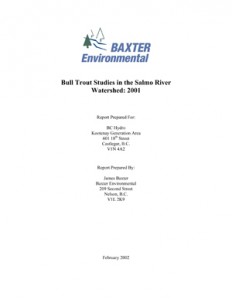 Bull Trout Studies in the Salmo River Watershed: 2001; Baxter Environmental: James Baxter; February 2002; 19 pgs.
Bull Trout Studies in the Salmo River Watershed: 2001; Baxter Environmental: James Baxter; February 2002; 19 pgs.
This report summarizes the results of bull trout monitoring in the Salmo River watershed in 2001 by BC Hydro. Work conducted in 2001 included index swims and spawner and redd counts. In total, one initial watershed wide survey and six index section surveys were conducted. Bull trout were present in high densities in early summer within the surveyed section, but had begun their upstream spawning migrations by the end of July. In total, 28 redds and 92 spawners were enumerated in 2001. As previously documented, bull trout spawners and redds were observed in Sheep Creek, Clearwater Creek and the upper section of the Salmo River. We also observed mature bull trout and reeds in Stagleap Creek and the South Salmo River. Sheep Creek was the area of the highest concentration of spawning activity, followed by the upper Salmo River, Clearwater Creek, and the South Salmo River watershed. In general, the swimming observer saw more bull trout and redds than the bank observer in all streams that were surveyed. These differences were significant for both fish (P<0.001) and redds (P=0.003).
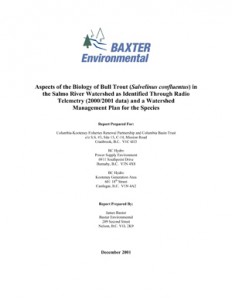 Aspects of the Biology of Bull Trout (Salvelinus confluentus) in the Salmo River Watershed as Identified Through Radio Telemetry (2000/2001 data) and a Watershed Management Plan for the Species; Baxter Environmental: James Baxter; December 2001; 117 pgs.
Aspects of the Biology of Bull Trout (Salvelinus confluentus) in the Salmo River Watershed as Identified Through Radio Telemetry (2000/2001 data) and a Watershed Management Plan for the Species; Baxter Environmental: James Baxter; December 2001; 117 pgs.
Over two years (1999-2001) a total of twenty bull trout were implanted with radio tags in the Salmo River watershed to determine the life-history and habitat use of the population. The specific objectives of the project were to identify major spawning, summering and overwintering areas, as well as to provide data on migration and spawning timing. A secondary objective was to determine if there was a migration to, or from, Seven Mile Reservoir by radio tagged bull trout. This report also summarizes the current status of the Salmo River bull trout population, and makes recommendations as to future management requirements.
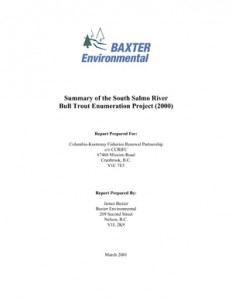 Summary of the South Salmo River Bull Trout Enumeration Project (2000); Baxter Environmental: James Baxter; March 2001; 20 pgs.
Summary of the South Salmo River Bull Trout Enumeration Project (2000); Baxter Environmental: James Baxter; March 2001; 20 pgs.
An enumeration fence and traps were installed on the South Salmo River from September 11th to October 24th, 2000 to enable the capture of post-spawning bull trout emigrating out of the watershed, and to capture five additional bull trout for the ongoing radio telemetry project. During the study period, a total of fifteen bull trout were sampled through the enumeration fence, and five were radio tagged. In total, seven males and eight females were processed through the fence. The average length of males was 58.9 cm, while the average length of females was 52.2 cm. Two bull trout sampled at the fence were originally radio tagged in 1999. One was a male, and one was a female. Over the year the male grew 3.5 cm, and the female grew 4.0 cm. The only other fish caught at the enumeration fence was a 30 cm largescale sucker. We also used the project as an educational tool for local elementary and high school students.
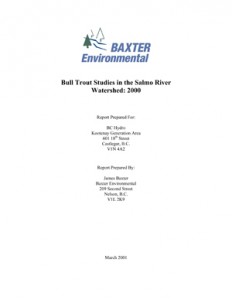 Bull Trout Studies in the Salmo River Watershed: 2000; Baxter Environmental: James Baxter; March 2001; 31 pgs.
Bull Trout Studies in the Salmo River Watershed: 2000; Baxter Environmental: James Baxter; March 2001; 31 pgs.
This report summarizes the results of studies that have been undertaken in the Salmo River watershed by BC Hydro in 2000. The work has focussed on documenting the status of the bull trout population in the watershed, and on collecting data that can be used for habitat enhancement purposes. Specific components of the work included redd counts, snorkel surveys, and water quality monitoring.
Assessment of a Constructed Non-Sportfish Migration Barrier on the Salmo River Using Radio Telemetry and Floy Tagging; Baxter Environmental: James Baxter; February 2001; 64 pgs.
In 1989, BC Hydro constructed a fish migration barrier on the Salmo River to limit the upstream movement of non-sportfish (predominantly sucker (Catostomus spp.) and northern pikeminnow (Ptychocheilus oregonensis)) from Seven Mile Reservoir into the upper Salmo River. During this study, I assessed whether the barrier was functioning in its intended design (10 years post-construction) by Floy tagging and radio tagging sucker and pikeminnow below the barrier in the early summer, and monitoring the movements of the tagged fish. The results of the study are discussed with relation to the potential impacts of non-sportfish on the trout and char populations of the Salmo River, and the possibility of barrier enhancement.
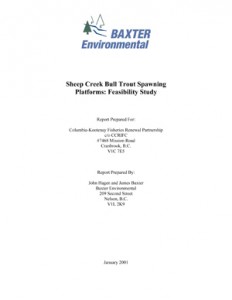 Sheep Creek Bull Trout Spawning Platforms: Feasibility Study; Baxter Environmental: John Hagen, James Baxter; January 2001; 22 pgs.
Sheep Creek Bull Trout Spawning Platforms: Feasibility Study; Baxter Environmental: John Hagen, James Baxter; January 2001; 22 pgs.
Field staff of Baxter Environmental have suggested that bull trout spawning in the Salmo River tributary Sheep Creek may be limited, based on observations of apparent redd superimposition and hydrological factors that have limited gravel recruitment. Although spawning habitat limitation likely cannot be demonstrated directly, this report details a cursory feasibility study for potential spawning habitat enhancements.
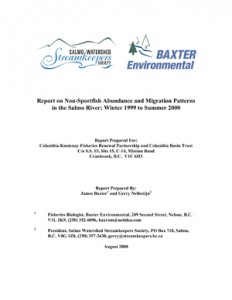 Report on Non-Sportfish Abundance and Migration Patterns in the Salmo River: Winter 1999 to Summer 2000; James Baxter, Gerry Nellestijn; August 2000; 16 pgs.
Report on Non-Sportfish Abundance and Migration Patterns in the Salmo River: Winter 1999 to Summer 2000; James Baxter, Gerry Nellestijn; August 2000; 16 pgs.
In 1999 the Salmo Watershed Streamkeepers Society (SWSS) felt that it was necessary to begin to address local concerns that non-sportfish abundance was increasing in the Salmo River watershed. Linked to this was the suspicion in the local community that non-sportfish intrusion from Seven Mile Reservoir was the cause in the perceived decline in rainbow trout and bull trout populations in the system. The following report is our attempt to start to understand the biology, and possible impacts, of the non-sportfish community in the Salmo River watershed.
This report documents the seasonal abundance and migration patterns of non-sportfish species (suckers and northern pikeminnow) in the Salmo River below the town of Salmo. We documented upstream movements of suckers into the river from late June to mid July 2000. The presence of Floy tagged suckers in the upper river confirmed that non-sportfish do migrate upstream of the previously constructed fish barrier. It also appears that these species migrate out of the mainstem Salmo River in early December. We discuss the results of our project within the scope of possible effects on sport fish populations, and make recommendations as to areas for future study.
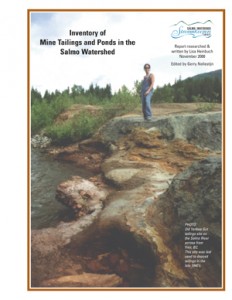 Inventory of Mine Tailings and Ponds in the Salmo Watershed; Lisa Heinbuch, Gerry Nellestijn; November 2000; 65 pgs.
Inventory of Mine Tailings and Ponds in the Salmo Watershed; Lisa Heinbuch, Gerry Nellestijn; November 2000; 65 pgs.
The purpose of this report is to compile a general inventory and brief history of the historical mines, tailing piles, and ponds in the Salmo River Watershed. We have broken the watershed down into specific areas in which there was dense mine development. Each area is discussed and the major producing mines and mills and significant tailing piles are located. These areas include some of the tributaries of the Salmo River as well as the river itself. We have prepared maps in order to give a visual perspective of the density of mines in each area. It is necessary to say that these maps are in no way exhaustive, there were at one time in this valley, around the turn of the last century, some 600 operating mines. The Salmo Watershed Tailings and Mine Locations map illustrates all of the mines and tailings that we could look at in yellow; and the tailing piles of priority concern to the health of the Salmo River, in red. The tailing piles were prioritized by their visual size and proximity to water courses. The tailings of priority concern are significantly large and directly adjacent to the Salmo River.
We would like to stress that it is probable that the tailings these mines have produced may continue to have significant impact on our precious waterways. It is for this reason we are trying to identify areas of concern. We hope that each one of these areas will receive further attention in order to recruit them back toward naturally functioning ecosystems.
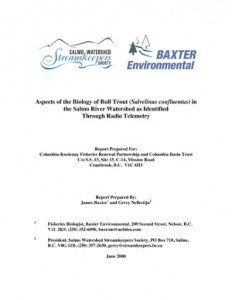 Aspects of the Biology of Bull Trout (Salvelinus confluentus) in the Salmo River Watershed as Identified Through Radio Telemetry; Baxter Environmental: James Baxter, Salmo Watershed Streamkeepers Society: Gerry Nellestijn; June 2000; 70 pgs.
Aspects of the Biology of Bull Trout (Salvelinus confluentus) in the Salmo River Watershed as Identified Through Radio Telemetry; Baxter Environmental: James Baxter, Salmo Watershed Streamkeepers Society: Gerry Nellestijn; June 2000; 70 pgs.
A total of ten bull trout (eight females and two males) were implanted with radio tags in the Salmo River watershed (nine in the mainstem Salmo River and one in Clearwater Creek). The average size of tagged fish was 57.0 cm fork length and 1972 g weight. Catch per unit effort averaged 0.44 bull trout per angler day, and post-surgery mortality was 0% as all bull trout underwent extensive upstream migrations to spawning areas. Bull trout began migrations to their spawning areas between July 15 and August 10 during a period of reduced decline in Salmo River discharge. Bull trout were tracked to a total of five spawning locations (the upper Salmo River, Clearwater Creek, Sheep Creek, the South Salmo River, and Stagleap Creek (tributary to the South Salmo River)), with one fish spawning in the United States of America (South Salmo River). During tracking four of the ten tagged fish entered the South Salmo watershed, with two fish utilizing the South Salmo River in the United States of America. Bull trout entered spawning tributaries as early as the first week of August, with spawning peaking in the first or second week of September. There was significantly more use of tributary habitat than mainstem habitat by radio tagged bull trout for spawning. Post-spawning migrations to overwintering habitat had generally occurred by the end of November, and it appeared that post-spawning mortality was 0% as all fish had moved significant distances downstream to overwintering areas. Overwintering habitat was limited to an 11 km section of the mainstem Salmo River between 13 km and 24 km, with some fish overwintering in the same pool in which they were originally tagged. Overwintering habitat was mainly in the form of deep pool in association with large woody debris or boulder. No tagged bull trout migrated into Seven Mile Reservoir, suggesting that the population is a fluvial population.
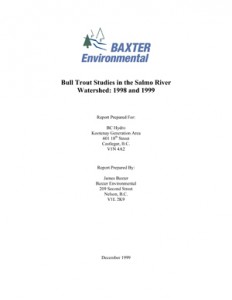 Bull Trout Studies in the Salmo River Watershed: 1998 and 1999; Baxter Environmental: James Baxter; December 1999; 57 pgs.
Bull Trout Studies in the Salmo River Watershed: 1998 and 1999; Baxter Environmental: James Baxter; December 1999; 57 pgs.
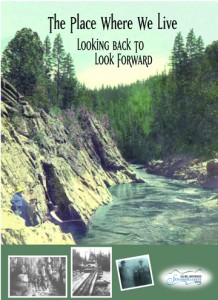 The Place Where We Live: Looking Back to Look Forward; Salmo Watershed Youth Assessment Project Team: Doug Ellis, Project Coordinator, Trevor Rushka, Chris Atha, Darcy Torrans, Vernon Cox, Christine Gilliland, Kurtis Black, Meredith Pritchard, Mike van Wijk; 1999, 118 pgs.
The Place Where We Live: Looking Back to Look Forward; Salmo Watershed Youth Assessment Project Team: Doug Ellis, Project Coordinator, Trevor Rushka, Chris Atha, Darcy Torrans, Vernon Cox, Christine Gilliland, Kurtis Black, Meredith Pritchard, Mike van Wijk; 1999, 118 pgs.
In the summer of 1999, the Salmo Watershed Streamkeepers Society (SWSS) partnered with Human Resources Development Canada (HRDC) to carry out an assessment of the Salmo River Watershed. This assessment was conducted to tell us ‘what is’ the condition of the environmental habitat of our main stem, tributaries and riparian area (the zone of influence between the land and water). SWSS was confused by the decline of fish populations in the Salmo River, especially the blue listed (threatened) bull trout. We saw HRDC’s Youth Services Canada (YSC) portfolio as the perfect match to drive this search. YSC encourages youth career development opportunities that leave the receiving community with a lasting legacy. This history is part of that legacy; the assessment itself is another part, as is a report on the Harlequin Duck, a beautiful bird that migrates here from the sea to rear its young. Some of our youth group were also involved in a radio telemetry study of bull trout. This is an intensive activity using high tech equipment to identify spawning and overwintering areas; a report based on this study will be finalized by the fall of 2000. Copies of this history, along with the Harlequin Duck and the Bull Trout Radio Telemetry reports, will be available at the Salmo Public Library as they are completed.

